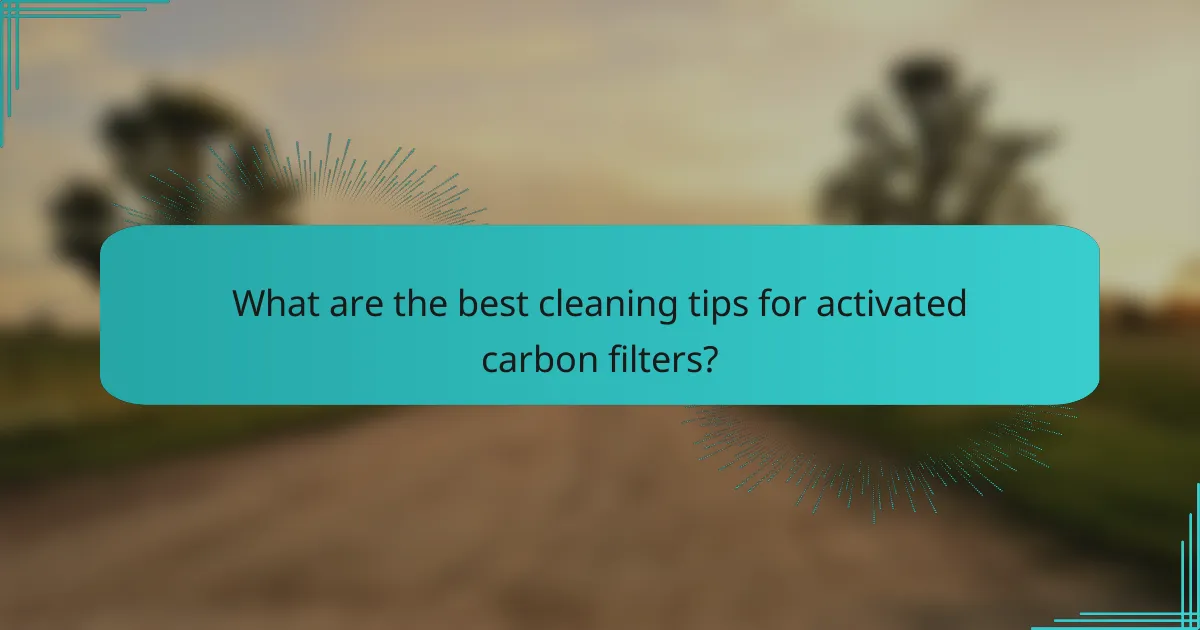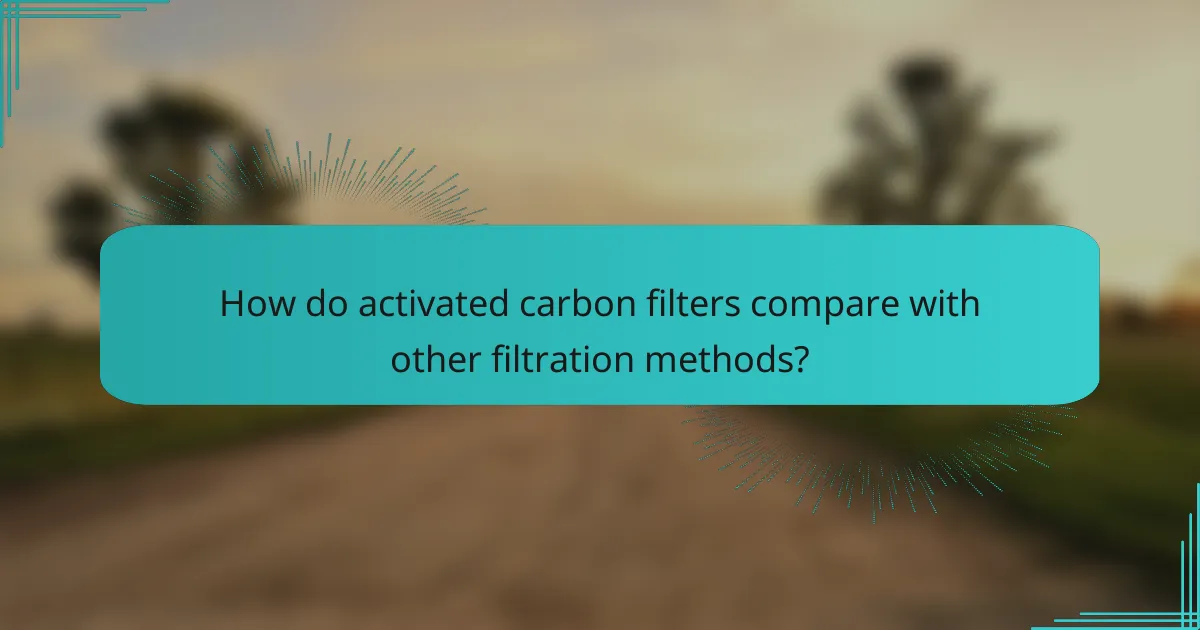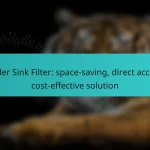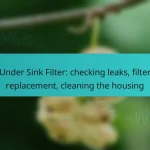Activated carbon filters play a crucial role in maintaining air and water quality, and it is essential to adhere to a replacement schedule, typically every 6 months, for optimal performance. Regular cleaning can further enhance their effectiveness and lifespan, ensuring they efficiently remove impurities. Additionally, proper storage in a cool, dry place away from light and moisture is vital to prevent degradation and maintain their functionality.

How often should you replace an activated carbon filter in the UK?
In the UK, it is generally recommended to replace an activated carbon filter every 6 months to ensure optimal performance. Regular replacement helps maintain air quality and efficiency in filtration systems.
Every 6 months for optimal performance
Replacing your activated carbon filter every 6 months is a good practice to ensure it functions effectively. Over time, the carbon can become saturated with impurities, reducing its ability to filter air or water. Regular changes help maintain the intended filtration capacity and improve overall system performance.
For households with pets or smokers, more frequent replacements may be necessary due to higher levels of contaminants. Consider setting a reminder to check and replace the filter semi-annually.
Signs of saturation include reduced airflow
One of the key indicators that your activated carbon filter needs replacing is a noticeable reduction in airflow. If you observe that your air purifier or water filtration system is not performing as well as it used to, it may be time for a change.
Other signs of saturation include unusual odors or a decline in water quality. If you experience any of these symptoms, check the filter and consider replacing it sooner than the 6-month mark.
Manufacturer guidelines may vary
Always refer to the manufacturer’s guidelines for specific recommendations regarding your activated carbon filter. Different brands and models may have unique requirements based on their design and intended use.
Some manufacturers may suggest replacement intervals that differ from the general 6-month rule, especially for specialized filters. Following these guidelines will help ensure your system operates efficiently and effectively.

What are the best cleaning tips for activated carbon filters?
To maintain the effectiveness of activated carbon filters, regular cleaning is essential. Proper cleaning techniques can help extend the lifespan of the filter and ensure optimal performance in removing impurities from air or water.
Rinse with water to remove dust
Start by rinsing the activated carbon filter under lukewarm water. This process helps eliminate loose dust and debris that can accumulate on the surface. Make sure to use a gentle stream to avoid damaging the filter material.
Rinsing should be done periodically, ideally every few weeks, depending on usage. If the filter is used in a high-dust environment, more frequent rinsing may be necessary.
Use a soft brush for stubborn particles
If rinsing alone does not remove all particles, a soft brush can be employed to gently scrub the surface. Use a brush with soft bristles to avoid scratching or damaging the activated carbon. Focus on areas where dirt and grime are more concentrated.
Brush cleaning should be done carefully and infrequently, as excessive scrubbing can wear down the filter material. Aim to clean with a brush only when necessary.
Avoid harsh chemicals
When cleaning activated carbon filters, it is crucial to avoid harsh chemicals or detergents. These substances can degrade the carbon material and reduce its effectiveness in filtering. Instead, stick to water and gentle cleaning methods.
Always check the manufacturer’s guidelines for cleaning recommendations. Following these guidelines helps ensure that the filter maintains its performance and longevity.

What are the ideal storage conditions for activated carbon filters?
Activated carbon filters should be stored in conditions that maintain their effectiveness and longevity. Proper storage involves keeping them in a cool, dry environment, away from light and moisture, to prevent degradation.
Store in a cool, dry place
Keeping activated carbon filters in a cool, dry place is essential for preserving their adsorption capabilities. Ideal temperatures are typically below 25°C (77°F), as higher temperatures can lead to faster degradation of the carbon material. Aim for a humidity level below 50% to avoid moisture absorption.
Consider using a temperature-controlled environment, such as a basement or a dedicated storage room, to ensure optimal conditions. Avoid areas near heat sources like radiators or ovens.
Avoid direct sunlight exposure
Direct sunlight can significantly reduce the effectiveness of activated carbon filters by causing chemical changes in the carbon structure. Ultraviolet (UV) rays can break down the carbon, leading to a loss of adsorption capacity.
Store filters in opaque containers or in a dark area to shield them from light. If using transparent containers, ensure they are kept in a shaded location to minimize exposure.
Seal in an airtight container
To maintain the integrity of activated carbon filters, sealing them in an airtight container is crucial. This prevents moisture and contaminants from entering, which can compromise their performance.
Use containers made of materials that do not react with carbon, such as glass or certain plastics. Ensure the lid is tightly secured to keep the filters dry and uncontaminated until they are ready for use.

What factors affect the lifespan of activated carbon filters?
The lifespan of activated carbon filters is influenced by several key factors, including water quality, usage frequency, and the type of contaminants present. Understanding these elements can help you optimize filter performance and determine the appropriate replacement schedule.
Water quality impacts filter longevity
Water quality plays a significant role in the lifespan of activated carbon filters. High levels of impurities, such as chlorine, sediment, and heavy metals, can lead to faster saturation of the carbon material. Regular testing of water quality can help you gauge how often you need to replace your filter.
For instance, if your water source has high turbidity or chemical content, you may need to change the filter more frequently, potentially every 2-4 weeks. In contrast, cleaner water sources may allow for a longer lifespan, extending to several months.
Usage frequency determines replacement needs
The frequency of filter usage directly affects how quickly the activated carbon becomes saturated. Filters used in households with heavy water consumption, such as those with multiple occupants or frequent cooking, will require more regular replacements. A general rule is to replace filters every 1-3 months based on usage.
For example, if you use your filter daily for drinking and cooking, consider checking it monthly. Conversely, if your usage is minimal, you might extend the replacement interval to every 6 months.
Type of contaminants influences saturation rate
The specific contaminants present in your water can significantly influence the saturation rate of activated carbon filters. Filters designed to remove specific pollutants, like volatile organic compounds (VOCs) or pesticides, may saturate faster when exposed to high levels of these substances.
For instance, if your water contains high levels of organic material, you may notice a reduction in filter effectiveness within weeks. It’s advisable to choose filters based on the contaminants you expect in your water supply, and monitor their performance regularly to ensure optimal filtration.

How do activated carbon filters compare with other filtration methods?
Activated carbon filters are effective for removing odors, chemicals, and some contaminants from air and water, but they differ significantly from other filtration methods in their capabilities and applications. While they excel at adsorption, they may not capture all particles or pathogens, making it essential to understand their strengths and limitations compared to alternatives like HEPA, reverse osmosis, and UV filters.
Activated carbon vs. HEPA filters
Activated carbon filters and HEPA filters serve different purposes in air purification. HEPA filters are designed to trap particulate matter, including dust, pollen, and pet dander, with an efficiency of at least 99.97% for particles as small as 0.3 microns. In contrast, activated carbon filters focus on removing gases and odors through adsorption but are less effective against solid particles.
For optimal air quality, many systems combine both filter types. This dual approach allows for the removal of both airborne particles and unpleasant odors, making it suitable for homes with allergy sufferers or pets.
Activated carbon vs. reverse osmosis
Activated carbon filters and reverse osmosis (RO) systems target different contaminants in water. While activated carbon is effective for removing chlorine, volatile organic compounds (VOCs), and some heavy metals, reverse osmosis is designed to eliminate a broader range of impurities, including dissolved salts and minerals. RO systems can remove up to 99% of contaminants, making them ideal for improving water quality.
However, RO systems often require more maintenance and can waste water during the filtration process. For households needing to address specific chemical contaminants, a combination of activated carbon and reverse osmosis may provide comprehensive water treatment.
Activated carbon vs. UV filters
Activated carbon filters and ultraviolet (UV) filters serve distinct roles in water and air purification. UV filters are primarily used to disinfect by killing bacteria, viruses, and other pathogens using ultraviolet light. They do not remove chemical contaminants or odors, which is where activated carbon excels.
For effective water treatment, combining activated carbon with UV filtration can enhance safety and taste. This combination allows for the removal of both harmful microorganisms and unpleasant chemicals, ensuring cleaner and safer drinking water.

What are the common misconceptions about activated carbon filters?
Activated carbon filters are often misunderstood, leading to incorrect assumptions about their capabilities. Many people believe these filters can completely purify water or eliminate all harmful contaminants, which is not the case.
Activated carbon filters do not purify water
Activated carbon filters are designed to improve water quality by removing specific impurities, but they do not purify water entirely. They primarily target chlorine, sediment, and some volatile organic compounds (VOCs), enhancing taste and odor but leaving behind other contaminants.
For effective purification, additional treatment methods such as reverse osmosis or UV filtration may be necessary. Users should consider their specific water quality needs and choose appropriate filtration systems accordingly.
They cannot remove all contaminants
While activated carbon filters are effective at reducing certain pollutants, they cannot remove all contaminants from water. Heavy metals, nitrates, and some microorganisms may still be present after filtration.
It is essential to understand the limitations of activated carbon filters and to regularly test water quality. For comprehensive protection, consider combining activated carbon with other filtration technologies to address a broader range of contaminants.


